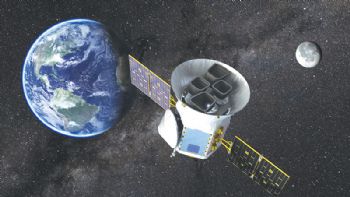
NASA’s Transiting Exoplanet Survey Satellite (TESS) has set out on its first-of-its-kind mission to find worlds beyond our solar system, including some that could support life.
Expected to find thousands of new exoplanets (planets beyond our own solar system) orbiting nearby stars, TESS was launched late last month on a SpaceX Falcon 9 rocket from Cape Canaveral Air Force Station in Florida.
Over the course of several weeks, TESS will use six thruster burns to travel in a series of progressively elongated orbits to reach the Moon, which will provide a gravitational assist so that TESS can transfer into its 13.7-day final ‘science orbit’ around Earth.
After about 60 days of check-out and instrument testing, the spacecraft will begin its two-year survey, for which scientists have divided the sky into 26 sectors.
TESS will use four wide-field cameras to map 13 sectors covering most of the southern sky during its first year of observations and 13 sectors covering most of the northern sky during the second year (85% of the sky in total).
It will be watching for phenomena called transits; these occurs when a planet passes in front of its star from the observer’s perspective, causing a periodic and regular dip in the star’s brightness. More than 78% of some 3,700 confirmed exoplanets have been found using transits.
NASA’s Kepler spacecraft found more than 2,600 exoplanets — most of them orbiting faint stars between 300 and 3,000 light-years from Earth — using this transit method.
TESS will focus on stars between 30 and 300 light-years away and 30- to 100-times brighter than Kepler’s targets.
The brightness of these target stars will allow researchers to use spectroscopy (the study of the absorption and emission of light) to determine a planet’s mass, density and atmospheric composition.
Water and other key molecules in a planet’s atmosphere can give hints about its capacity to harbour life.
More information about TESS can be found at the Web site (
www.nasa.gov/tess).